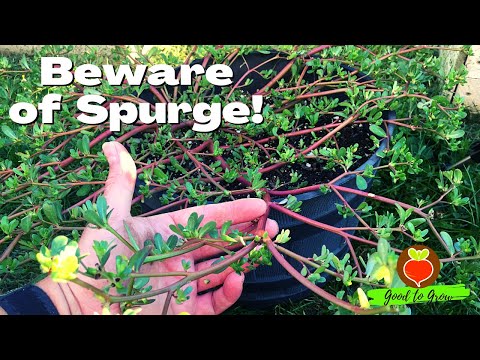One of the most fundamental skills that any prepper can possess in a survival situation is knowing how to forage for food.

Nature can provide us with all sorts of nutritious things to eat if we know where to look, know how to harvest them and know how to prepare them.
But not everything is edible, and not everything is edible and not everything is edible in its raw form.
You’ll need to know what’s what before you dig in unless you want to make your situation even worse.
Today we are looking at purslane. Is it safe to eat purslane raw in order to survive?
Yes, purslane is completely safe to eat when raw, and it’s also highly nutritious. This makes it an excellent survival vegetable if you can find it and harvest it, but you must watch out for dangerously toxic look-alike plants.
Most of the time, purslane is considered a nuisance plant because it has a tendency to act like a weed, crowding out and killing other low-growing vegetation.
This makes it a constant target of gardeners and groundskeepers, but purslane actually has a secret life as a super nutritious vegetable that you’d be wise to incorporate into your diet and utilize as a survival food.
I’ll tell you everything you need to know about eating purslane, raw or not, below…
Be Careful: Some Toxic Plants Look Similar to Purslane!
As with most wild edible plants, the prepared survivor must have a working knowledge of look-alike plants.
Accidentally coming into contact with or, worse, eating a toxic impostor could make your situation a whole lot worse, or even spell death outright.

In the case of our purslane here, one of the most plentiful and also the most dangerous toxic imposters is spurge, specifically prostrate spurge.
It’s another low-growing plant that looks very much like the delicious and nutritious purslane that we want to collect and eat. But that’s where the similarities end…
Prostrate spurge contains and secretes a sticky, white or off-white sap that causes dreadful inflammation on skin, and is especially damaging to mucous membranes and other soft tissues.
If you are lucky, you’ll walk away from a close encounter with this plant with nothing more than a serious rash, but if you get it in your eyes you might suffer from temporary blindness.
Suffice it to say, if you actually eat it, you are going to be in for a very bad time, and it isn’t out of the question that your throat could swell closed or even block your airway.
Accordingly, it is imperative that you learn to positively identify purslane if it’s something you’re going to rely on out in the wild, especially if it is common in your region.
Mistaking at purslane for the highly similar prostrate spurge might be the last mistake you make during your ordeal.
Does Purslane Taste Good?
Purslane is one plant that most people have never tried, although it is still a common inclusion in many dishes in other cultures around the world.
To tell you the truth, purslane has a slightly unusual taste for a leafy vegetable.
Those that tried often describe it as bitter, tangy, peppery and sometimes salty, and depending on what plants it grows near and the environment, it might have subtle citrus notes.
Most folks that I have talked to that have tried it for the first time say it compares somewhat favorably with arugula.
That being said, it is a popular vegetable in all of these cultures for a reason, and after you try it you’ll probably like it, making it an even better bet as a survival food since you won’t have to hold your nose to choke it down!

Are Purslane Roots Safe to Eat?
Yes. Purslane roots are safe to eat and no part of the plant is toxic or harmful. Raw or cooked, you can eat the roots, though they aren’t the most nutritious part of the plant.
Are Purslane Leaves Safe to Eat?
Yes, they are, and this is the real prize as far as our efforts are concerned. The leaves are the tastiest and the most nutritious part of the plant, and so long as they are fresh and healthy you’ll find them moist, crisp and highly edible.
They can be eaten raw or cooked at your preference, though they are better by far raw.
Are Purslane Stalks and Stems Safe to Eat?
Yes, they sure are. The stems and stalks of purslane are tender and delicate compared to many other plants, and they are edible right along with the leaves.
Can You Eat Cooked Purslane to Survive?
You can, but this isn’t necessary: Purslane is already so tender and crisp that it does not require cooking, and cooking will only serve to reduce the nutritional content, anyway…
However, purslane is prepared in all sorts of toppings and dishes around the world, so you definitely can cook with it and cooking does have one major advantage in that it will kill off any harmful germs that might be in or on the plant. More on that in a minute.

Purslane Nutritional Info
Purslane is highly nutritious, and even has a meaningful amount of macronutrients in the form of protein and carbs.
The vitamin profile is very good, and purslane has tons of vitamin C and vitamin E along with respectable amounts of the B-complex vitamins, particularly thiamine, riboflavin, niacin, pantothenic acid, B6 and folate. Notably, you only get trace amounts of vitamin A and vitamin K…
The mineral profile of purslane is really quite remarkable. This leafy plant will provide you with iron, calcium, manganese, magnesium, potassium and small amounts of zinc and phosphorus.
All told, this is a really remarkable nutritional profile for any vegetable, to say nothing of one that is usually derided and persecuted as a common weed!
Together, all of these nutrients can help give you energy, regulate cellular function, improve electrolyte balance, tissue healing, blood oxygenation and more.
It isn’t nutritionally complete, but very few vegetables are, and you’ll be hard-pressed to do better concerning wild edibles then you can with purslane.
Where Does Purslane Grow?
Today, purslane is found all over the world, and it has been spread by human trade, exploration, travel and other activities for a very long time.
However, it’s thought to be present in North America only in isolated pockets. That being said, if you were anywhere else around the globe, including Europe, Asia and Africa, you’ll find purslane for sure.
Also, keep in mind that purslane is routinely spread by hitching a ride on other plants, and in soil that has been “contaminated” by it.
As such, you’re just as likely to find it popping up unexpectedly in gardens, in landscaping, and even on farms.
Like I mentioned above, many gardeners, groundskeepers and farmers simply think of this nutritious plant as a highly invasive weed, and in that context I guess it is, but that shouldn’t stop you from looking for in these places and harvesting it if you can.
Any Health Issues to Worry About When Eating Purslane?
There are only a few minor health risks associated with eating purslane. One is a common risk shared with all raw vegetables, and wild forged vegetables in particular: the risk of a food poisoning and other foodborne illnesses.
Although this might not sound like the end of the world considering you aren’t worried about eating a toxic plant here, keep in mind that food poisoning might be enough to finish you off if you’re already in the middle of a survival situation.
Pronounced dehydration from vomiting and diarrhea could compromise an already stressed body! Cooking thoroughly, as always, will kill the germs associated with food poisoning.
The other risk associated with purslane is due to its high oxalic acid content.
Although not a problem for everyone, and not necessarily a problem at all unless you’re eating an awful lot of, high dietary levels of oxalic acid are known to cause the formation of kidney stones, or increase the size of existing stones.
If you’re already highly prone to this agonizing condition, think twice before eating too much purslane if you can avoid it.
via Modern Survival Online https://ift.tt/WUGQj9i
No comments:
Post a Comment